Effect of Process Variables for Reducing Assist Gas Pressure in 50 mm-Thick Stainless Steel Underwater Laser Cutting
Abstract
1. Introduction
1.1. Effect of Distance between the Nozzle and the Specimen
1.2. The Effect of Kerf Width
1.3. Effect of the Cutting-Nozzle Shape
2. Experiments
2.1. Underwater Assist Gas Flow Visualization
2.2. Underwater Laser Cutting
3. Result and Discussion
3.1. Effect of Nozzle Type
3.2. Effect of the Focus Position of Laser Beam
3.3. Cut Surface Roughness Analysis
4. Conclusions
- From the underwater gas flow visualization experiment, the top kerf width was assumed to be the dominant factor in determining the assist gas flow and the penetration depth. The assist gas penetrated deeper with increasing Gp = 1 mm to 2 mm.
- In an actual underwater laser-cutting experiment, cutting performance was determined through cut surface analysis. This is because, when the upper and middle striation lengths were long and the surface roughness was low, it was observed that the assist gas flowed well inside the cut surface. Depending on the nozzle type, the cutting performance was best when supersonic nozzles were used. However, because the top kerf width also increased, it was hard to directly compare the nozzles’ effects on the cutting performance.
- When the focus of the laser Fb was positioned deeper into the depth direction of the specimen, the cutting performance was improved. In the case of Fb = −30 mm, the specimen was able to cut well, even though the gas pressure was reduced from 10 bar to 8 bar and the striation length was not changed significantly. This is because, as analyzed in the assist gas visualization experiment, the deeper the focus position of the laser beam, the wider the top kerf and the better the flow of assist gas inside the cut surface.
- Therefore, the top kerf width should be large enough to accommodate the easy removal of the molten metal. In underwater laser cutting, to reduce the generation of radioactive aerosols, the assist gas pressure was lowered by widening the kerf width. The kerf width was highly dependent on the laser beam focus position. Based on the results of this study, it is recommended to set the focus of the laser beam deep in the cutting object when dismantling the RVI underwater.
Author Contributions
Funding
Institutional Review Board Statement
Informed Consent Statement
Data Availability Statement
Conflicts of Interest
References
- Anunti, Å.; Larsson, H.; Edelborg, M. Decommissioning Study of Forsmark NPP (R-13-03); Swedish Nuclear Fuel and Waste Management Co.: Stockholm, Sweden, 2013; ISSN 1402-3091. [Google Scholar]
- Jain, R.K.; Agrawal, D.K.; Vishwakarma, S.C.; Choubey, A.K.; Upadhyaya, B.N.; Oak, S.M. Development of underwater laser cutting technique for steel and zircaloy for nuclear applications. Pramana 2010, 75, 1253–1258. [Google Scholar] [CrossRef]
- Khan, A.; Hilton, P. Optimisation of underwater laser cutting for decommissioning purposes. J. Laser Appl. 2014, 2014, 294–302. [Google Scholar] [CrossRef]
- Leschke, J.; Barroi, A.; Kaierle, S.; Hermsdorf, J.; Overmeyer, L. Studies on the Robustness of Underwater Laser Cutting of S355J2+N Using a Yb:YAG Disk Laser Source. Phys. Procedia 2016, 83, 310–316. [Google Scholar] [CrossRef]
- Shin, J.S.; Oh, S.Y.; Park, H.; Kim, T.-S.; Lee, L.; Chung, C.-M.; Lee, J. Underwater cutting of 50 and 60 mm thick stainless steel plates using a 6-kW fiber laser for dismantling nuclear facilities. Opt. Laser Technol. 2019, 115, 1–8. [Google Scholar] [CrossRef]
- Choubey, A.; Jain, R.; Ali, S.; Singh, R.; Vishwakarma, S.; Agrawal, D.; Arya, R.; Kaul, R.; Upadhyaya, B.; Oak, S. Studies on pulsed Nd:YAG laser cutting of thick stainless steel in dry air and underwater environment for dismantling applications. Opt. Laser Technol. 2015, 71, 6–15. [Google Scholar] [CrossRef]
- Peillon, S.; Fauvel, S.; Chagnot, C.; Gensdarmes, F. Aerosol Characterization and Particle Scrubbing Efficiency of Underwater Operations during Laser Cutting of Steel Components for Dismantling of Nuclear Facilities. Aerosol Air Qual. Res. 2017, 17, 1463–1473. [Google Scholar] [CrossRef]
- Kim, S.I.; Lee, H.Y.; Song, J.S. A study on characteristics and internal exposure evaluation of radioactive aerosols during pipe cutting in decommissioning of nuclear power plant. Nucl. Eng. Technol. 2018, 50, 1088–1098. [Google Scholar] [CrossRef]
- Segerud, P.; Boucau, J. Latest Experience from José Cabrera Reactor Vessel Dismantling Project–15214; WM Symposia, Inc.: Tempe, AZ, USA, 2015; pp. 1–9. [Google Scholar]
- Pospíšil, P. Reactor Vessel Internals Segmentation Experience using Mechanical Cutting Tools. Technol. Eng. 2013, 10, 6–10. [Google Scholar] [CrossRef][Green Version]
- Marimuthu, S.; Nath, A.K.; Dey, P.K.; Misra, D.; Bandyopadhyay, D.K.; Chaudhuri, S.P. Design and evaluation of high-pressure nozzle assembly for laser cutting of thick carbon steel. Int. J. Adv. Manuf. Technol. 2017, 92, 15–24. [Google Scholar] [CrossRef]
- Zhang, C.; Wen, P.; Yuan, Y.; Fan, X. Evaluation and optimal design of supersonic nozzle for laser-assisted oxygen cutting of thick steel sections. Int. J. Adv. Manuf. Technol. 2016, 86, 1243–1251. [Google Scholar] [CrossRef]
- Orazi, L.; Darwish, M.; Reggiani, B. Investigation on the Inert Gas-Assisted Laser Cutting Performances and Quality Using Supersonic Nozzles. Metals 2019, 9, 1257. [Google Scholar] [CrossRef]
- Oh, S.Y.; Shin, J.S.; Kim, T.S.; Park, H.; Lee, L.; Chung, C.-M.; Lee, J. Effect of nozzle types on the laser cutting performance for 60-mm-thick stainless steel. Opt. Laser Technol. 2019, 119, 105607. [Google Scholar] [CrossRef]
- Tamura, K.; Toyama, S. Laser cutting performances for thick steel specimens studied by molten metal removal conditions. J. Nucl. Sci. Technol. 2017, 54, 1011–1017. [Google Scholar] [CrossRef]
- Goppold, C.; Pinder, T.; Herwig, P. Dynamic Beam Shaping for Thick Sheet Metal Cutting. LiM 2017, 1–9. [Google Scholar]
- Morimoto, Y.; He, D.; Hijikata, W.; Shinshi, T.; Nakai, T.; Nakamura, N. Effect of high-frequency orbital and vertical oscillations of the laser focus position on the quality of the cut surface in a thick plate by laser beam machining. Precis. Eng. 2015, 40, 112–123. [Google Scholar] [CrossRef]
- Man, H.; Duan, J.; Yue, T. Design and characteristic analysis of supersonic nozzles for high gas pressure laser cutting. J. Mater. Process. Technol. 1997, 63, 217–222. [Google Scholar] [CrossRef]
- Shin, J.S.; Oh, S.Y.; Park, H.; Chung, C.M.; Seon, S.; Kim, T.S.; Lee, L.; Lee, J. Laser Cutting of Steel Plates up to 100 mm in Thickness with a 6-KW Fiber Laser for Application to Dismantling of Nuclear Facilities. Opt. Lasers Eng. 2018, 100, 98–104. [Google Scholar] [CrossRef]
- Kim, K.; Song, M.-K.; Lee, S.-J.; Shin, D.; Suh, J.; Kim, J.-D. Fundamental Study on Underwater Cutting of 50 mm-Thick Stainless Steel Plates Using a Fiber Laser for Nuclear Decommissioning. Appl. Sci. 2022, 12, 495. [Google Scholar] [CrossRef]
- Kim, K.; Song, M.K.; Kim, J.D.; Lee, S.J.; Shin, D.; Cho, D.W. Effect of assist gas pressure on cutting quality in underwater cutting of stainless steel using high-power fiber laser. Mod. Phys. Lett. B 2022, 36, 2242012. [Google Scholar] [CrossRef]

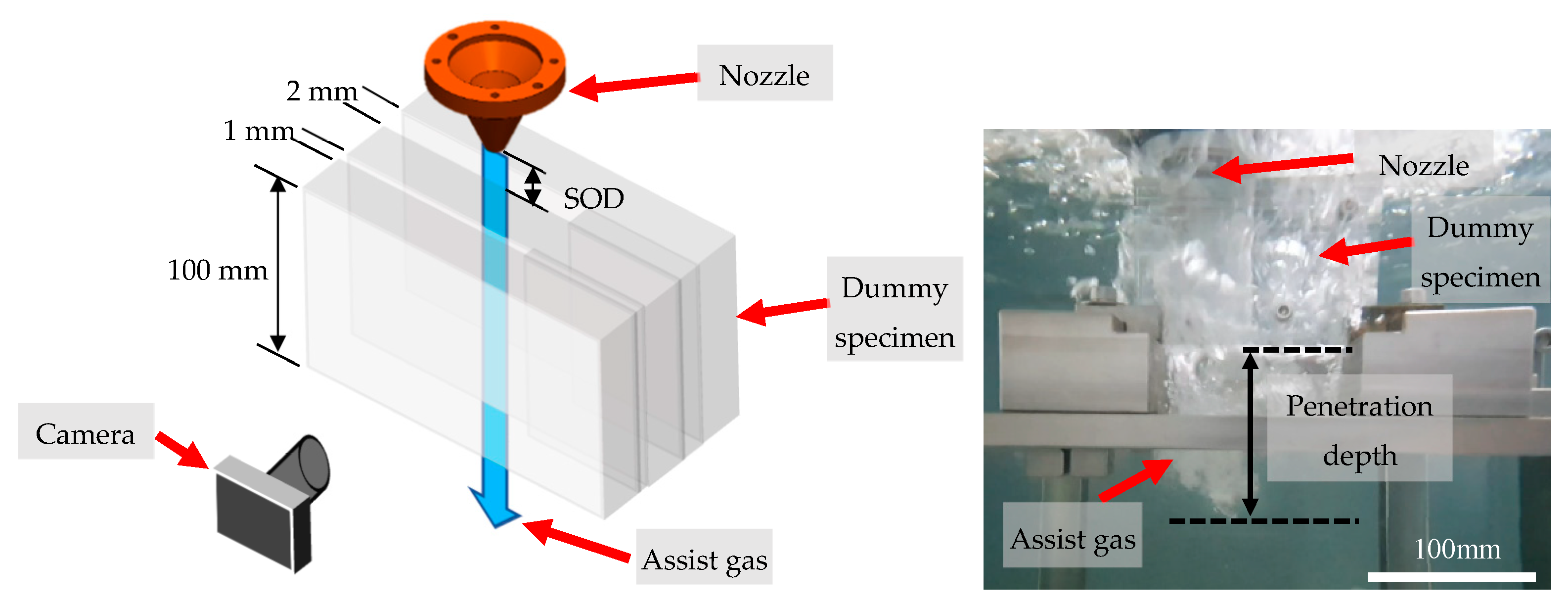
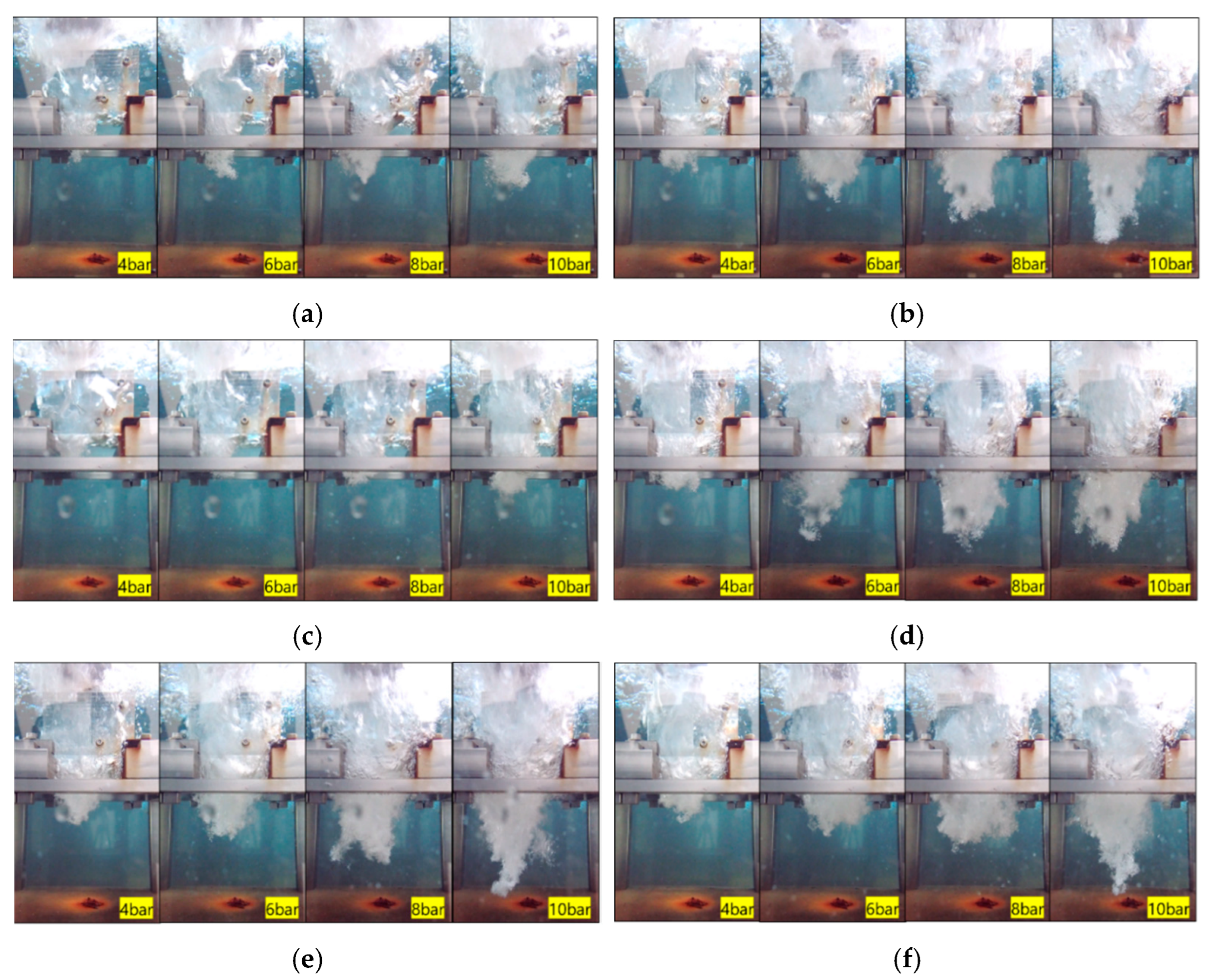
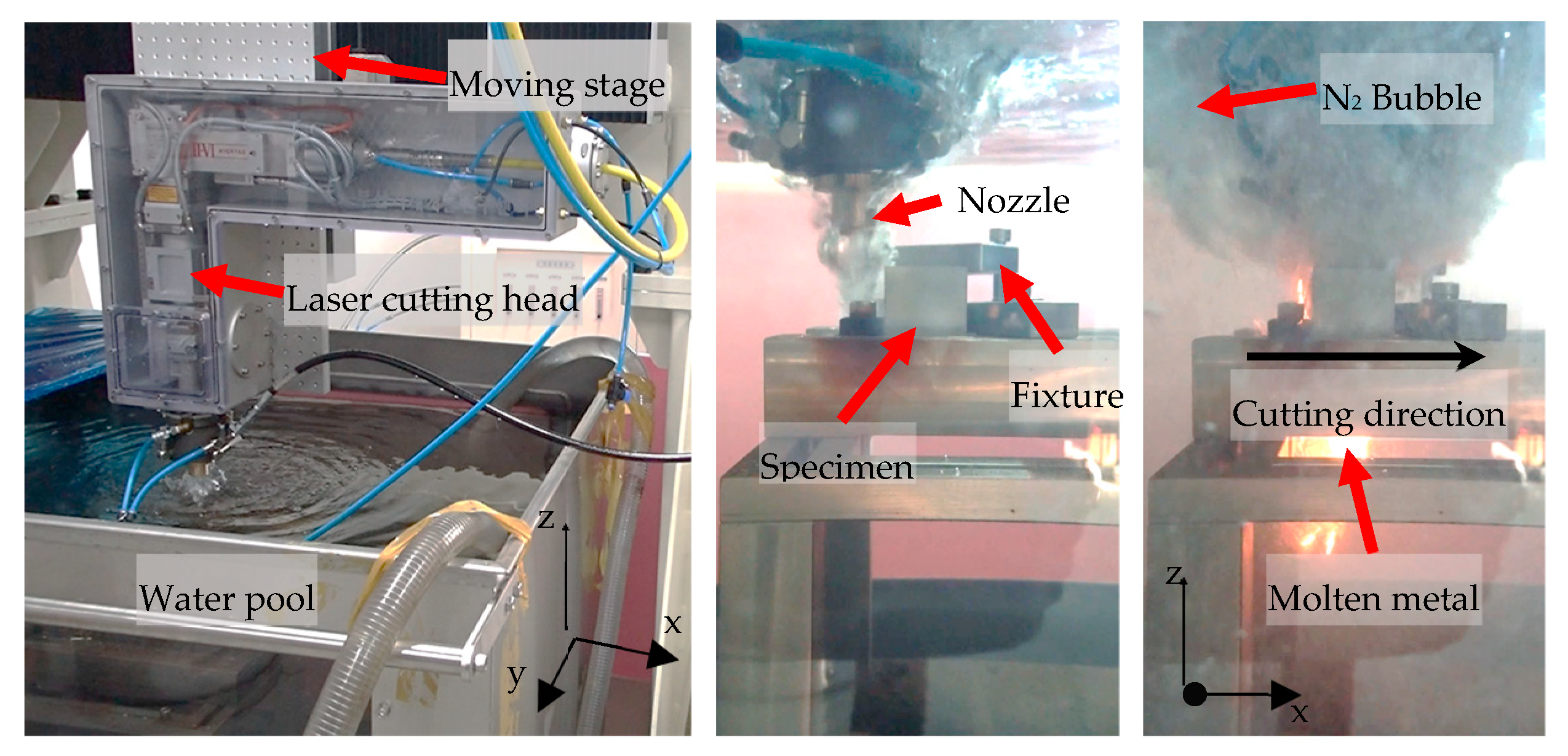
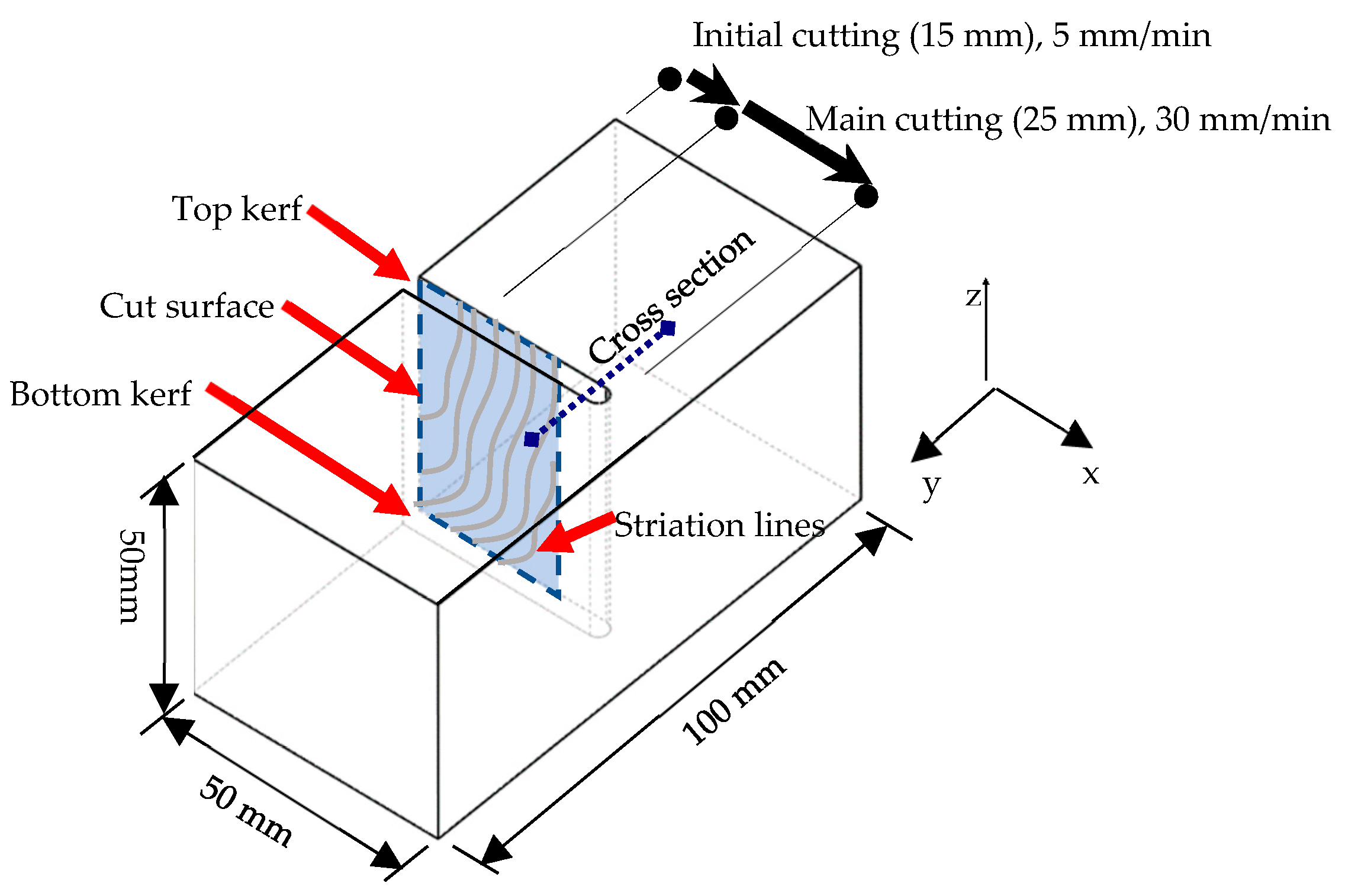
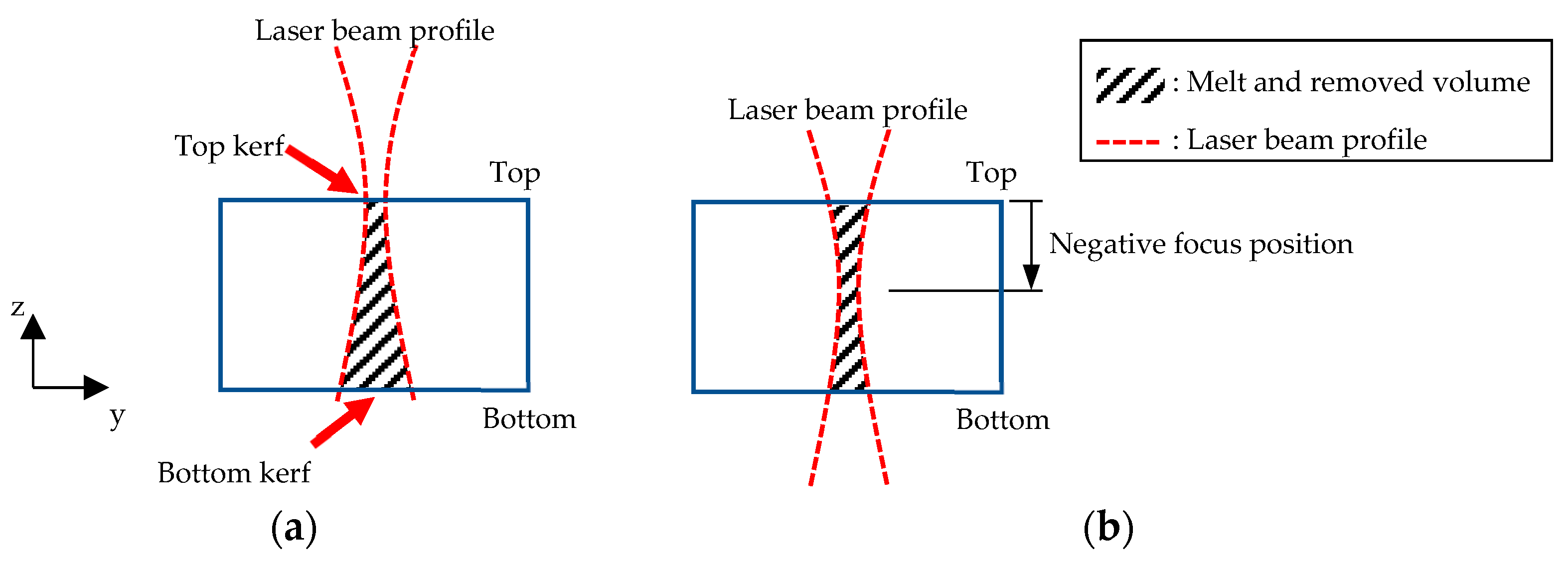
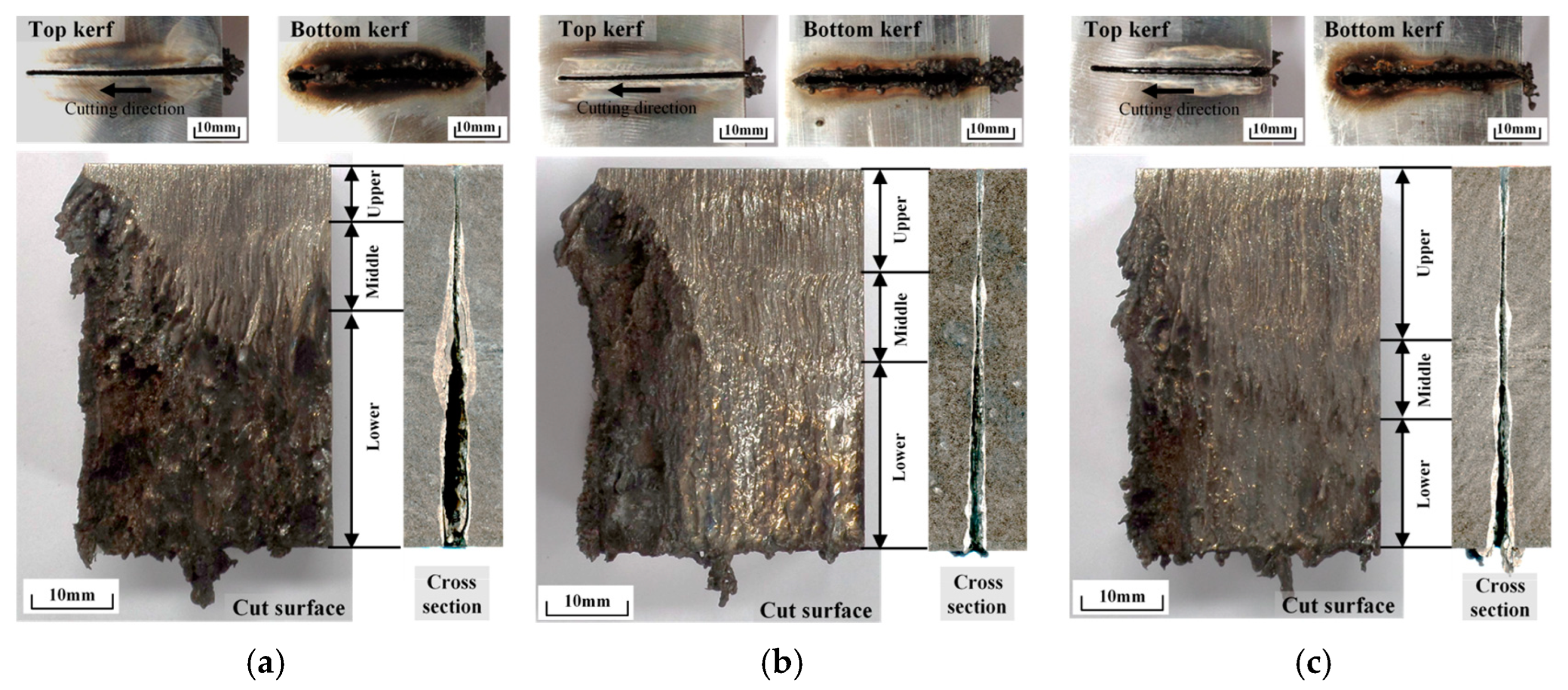
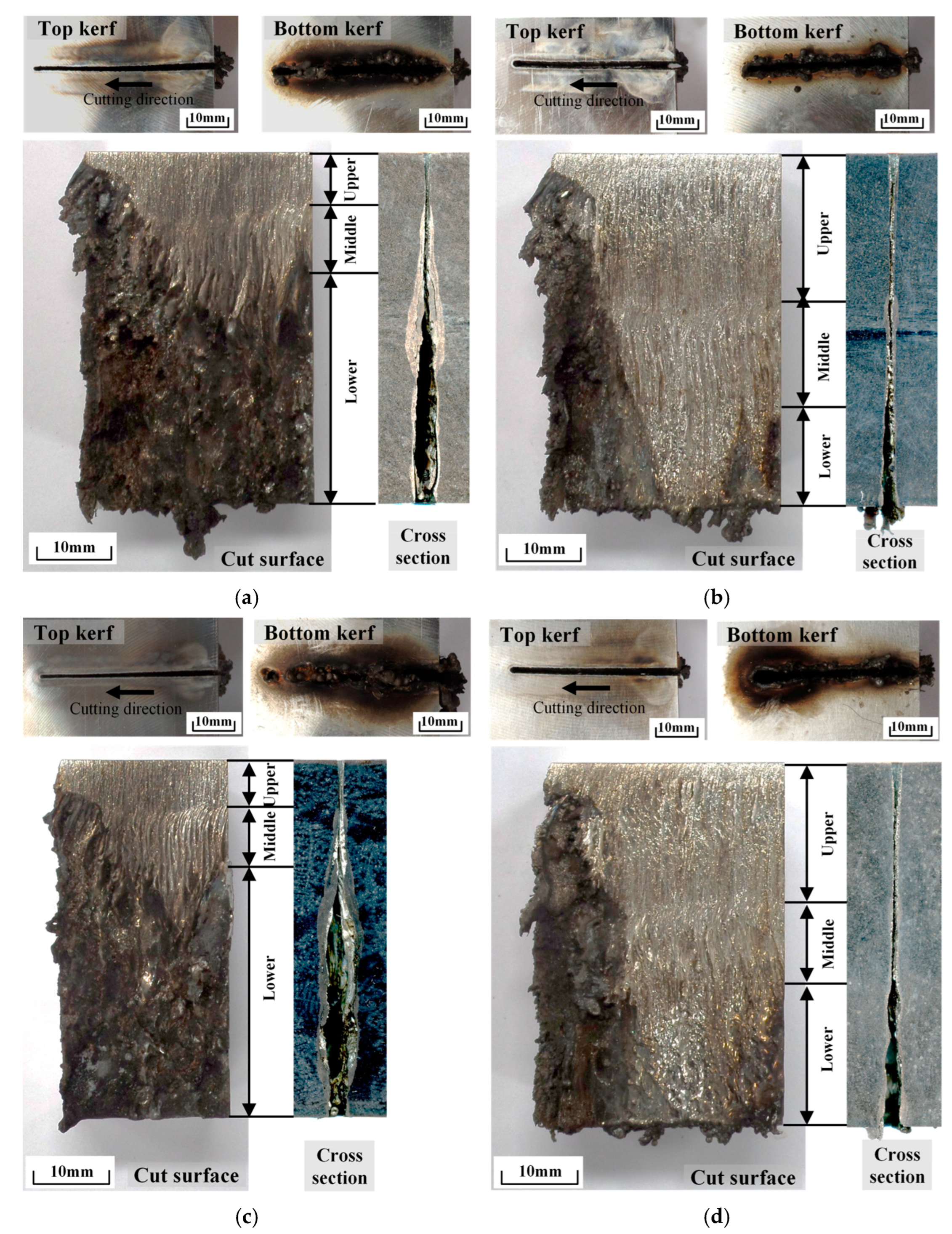
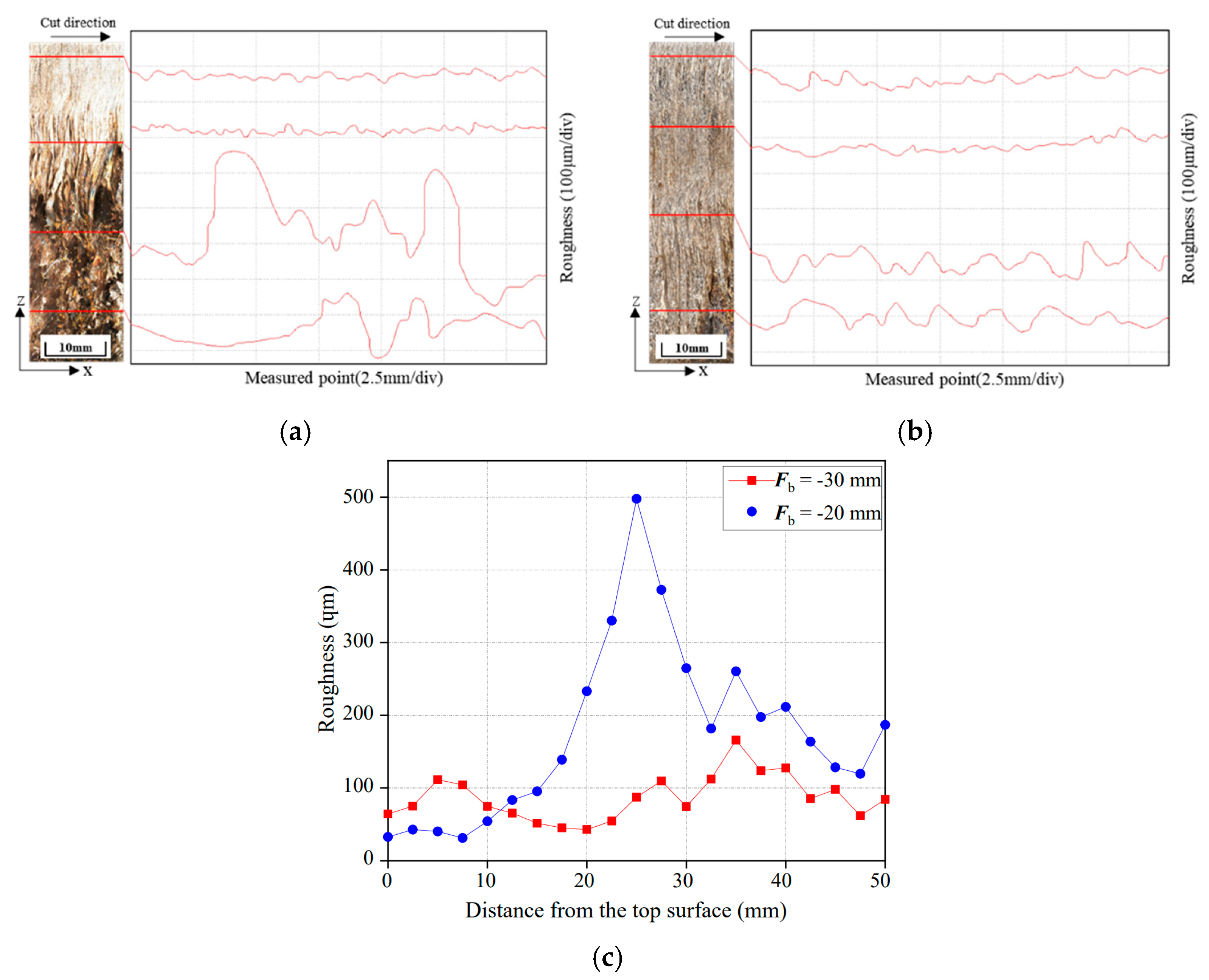
| Test No. | Nozzle Type | Gap between the Plates (Gp, mm) | Stand-Off Distance (Dn, mm) | Assist Gas Pressure (Pg, bar) |
|---|---|---|---|---|
| 1-1 | Conical | 1 | 1 | 4, 6, 8, 10 |
| 1-2 | Conical | 2 | 1 | |
| 2-1 | Supersonic | 1 | 1 | |
| 2-2 | Supersonic | 2 | 1 | |
| 3-1 | Conical–flat | 2 | 0 | |
| 3-2 | Conical–flat | 2 | 1 |
| Laser Power (kW) | Feed Rate (Vc, mm/min) | Focus Position of Beam (Fb, mm) | Assist Gas Pressure (Pg, bar) | Stand-Off Distance (Dn, mm) | Nozzle Types |
|---|---|---|---|---|---|
| 9 | 30 | −20 | 10 | 1 | Conical Conical–flat Supersonic |
| Nozzle Type | Top Kerf Width (WTk, mm) | Bottom Kerf Width (WBk, mm) | Striation Line Length (mm) | ||
|---|---|---|---|---|---|
| Upper | Middle | Lower | |||
| Conical | 1.3 | 2.5 | 13.3 | 11.6 | 24.1 |
| Conical–flat | 1.3 | 3.1 | 7.5 | 13.6 | 28.9 |
| Supersonic | 1.9 | 1.6 | 22.3 | 10.4 | 17.3 |
| Laser Power (kW) | Feed Rate (Vc, mm/min) | Focus Position of Beam (Fb, mm) | Assist Gas Pressure (Pg, bar) | Stand-Off Distance (Dn, mm) | Nozzle Type |
|---|---|---|---|---|---|
| 9 | 30 | −20, −30 | 8, 10 | 1 | Conical–flat |
| Focus Position of Beam (Fb, mm) | Assist Gas Pressure (Pg, bar) | Top Kerf Width (WTk, mm) | Bottom Kerf Width (WBk, mm) | Striation Length (mm) | ||
|---|---|---|---|---|---|---|
| Upper | Middle | Lower | ||||
| −20 | 10 | 1.3 | 3.1 | 7.5 | 13.6 | 28.9 |
| −30 | 10 | 2.0 | 2.0 | 21.7 | 14.5 | 13.8 |
| −20 | 8 | 1.2 | 2.6 | 6.3 | 8.5 | 35.2 |
| −30 | 8 | 1.8 | 2.2 | 19.1 | 12.6 | 18.3 |
Publisher’s Note: MDPI stays neutral with regard to jurisdictional claims in published maps and institutional affiliations. |
© 2022 by the authors. Licensee MDPI, Basel, Switzerland. This article is an open access article distributed under the terms and conditions of the Creative Commons Attribution (CC BY) license (https://creativecommons.org/licenses/by/4.0/).
Share and Cite
Kim, R.; Lee, S.-J.; Choi, J.; Shin, D.; Kim, J.-D. Effect of Process Variables for Reducing Assist Gas Pressure in 50 mm-Thick Stainless Steel Underwater Laser Cutting. Appl. Sci. 2022, 12, 9574. https://doi.org/10.3390/app12199574
Kim R, Lee S-J, Choi J, Shin D, Kim J-D. Effect of Process Variables for Reducing Assist Gas Pressure in 50 mm-Thick Stainless Steel Underwater Laser Cutting. Applied Sciences. 2022; 12(19):9574. https://doi.org/10.3390/app12199574
Chicago/Turabian StyleKim, Ryoonhan, Su-Jin Lee, Jungsoo Choi, Dongsig Shin, and Jong-Do Kim. 2022. "Effect of Process Variables for Reducing Assist Gas Pressure in 50 mm-Thick Stainless Steel Underwater Laser Cutting" Applied Sciences 12, no. 19: 9574. https://doi.org/10.3390/app12199574
APA StyleKim, R., Lee, S.-J., Choi, J., Shin, D., & Kim, J.-D. (2022). Effect of Process Variables for Reducing Assist Gas Pressure in 50 mm-Thick Stainless Steel Underwater Laser Cutting. Applied Sciences, 12(19), 9574. https://doi.org/10.3390/app12199574






